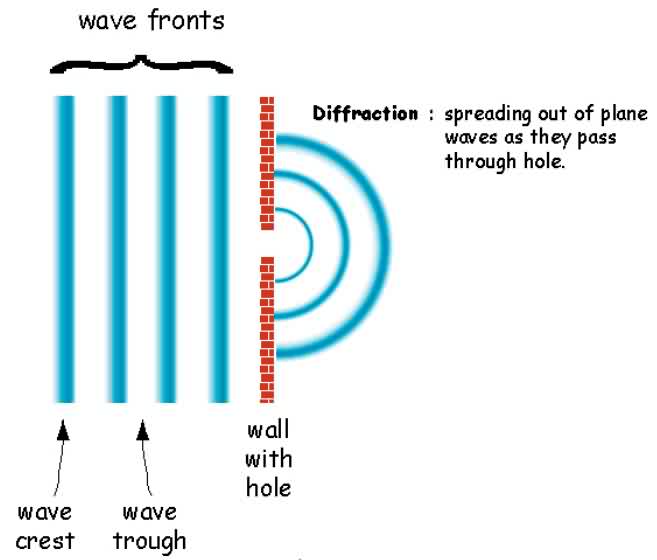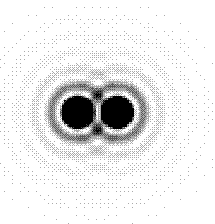 R2 =
R2 =  D2/4 , since R = D/2
D2/4 , since R = D/2Reading Assignment: Arny: Chapter 5, Overview IV, Chapter 7
We characterize the brightness of an object as some number of photons being collected per unit area per unit time. Brightness is therefore the amount of radiation received by us. We cannot change how bright an object is. But we can change the number of photons we collect.
We Can...
For human eyes the collecting area is only the total area of your two pupils. It's not very big. Furthermore, your eyes only collect light for about 1/30th of a second before they send the info to your brain and start collecting again (like frames of a movie). That's why when you look through a telescope at, say the Orion nebula, it does not look as impressive as it does in the pretty pictures in text books. Plus we cannot record precisely what our eyes saw and study it later quantitatively. So, we need telescopes...
We typically rate telescopes by the size of their collecting area. Since the collecting areas are usually circular we describe them in terms of their diameters:
A typically large telescope has a diameter of Dt = 4 m, whereas your dilated eye has a diameter of about De = 4 mm (4 x 10-3 m).
 R2 =
R2 =  D2/4 , since R = D/2
D2/4 , since R = D/2Ratio of areas:
At/Ae = ((4 m)/(4 x 10-3 m))2 = 1 x 106
The secondary purpose of a telescope is to provide greater resolution
Resolution is the ability to detect fine detail. For example, the bright star in the bend of the handle of the Big Dipper, Mizar, looks like just one star to your eye. But in a telescope it is revealed to be two stars. Your eye cannot resolve angles small enough to separate the two stars in the image on your retina. This is is because of a wave property that light has called diffraction. As a wave passes through an aperture the planar wave is converted into a spherical wave as seen in the following figure:

In a telescope (or your eye) which has a circular aperture this leads to point sources being surrounded by rings of light. When the rings of one point source overlap the rings of another it becomes impossible to discern one point source from the next.

 , that a circular aperture, with a diameter D, can resolve for light with wavelength
, that a circular aperture, with a diameter D, can resolve for light with wavelength  .
.

 1.22
1.22 /D
/D
What is the diffraction limit of the Keck telescope in Hawaii? It has a diameter of 10 m. It is an optical telescope, so let's use the middle wavelength of the optical spectrum as the fiducial wavelength,  = 5500 Å.
= 5500 Å.

 1.22(5500 x 10-10 m)/(10 m) = 6.7 x 10-8 radians * 206,265"/radian = 1.4 x 10-2" = 14 milli-arcseconds (mas)
1.22(5500 x 10-10 m)/(10 m) = 6.7 x 10-8 radians * 206,265"/radian = 1.4 x 10-2" = 14 milli-arcseconds (mas)The Keck Telescope does not actually achieve this small of an angle, however. The atmosphere blurs the light of any incoming point source and spreads the light out over a larger angle than the diffraction limit of the telescope.
This effect is wavelength dependent. Blue light slows down more in glass than does red light. This causes white light to spread into a rainbow of colors when it enters glass. This also means that when white light is passed through the lens of a refracting telescope the different colors will be focused to different points. Thus there will be no one place that you can put a detector and have the image all in focus. The image will have colored halos. This is called chromatic aberration.
In addition refracting telescopes have another limitation. It becomes prohibitively expensive to make lenses very large. Plus the need to support them only on their edges causes large lenses to sag in the middle and the tubes needed to hold them become gigantic. The largest refractor in the world is the Yerkes Observatory owned by the University of Chicago. It has a 40 inch diameter lens. At Lick Observatory on Mnt. Hamilton UC owns a 36-inch refractor. Hopefully, we'll get to view through it.
(2) Reflecting
Reflecting telescopes uses mirrors to bring light to a focus. In order for every ray of light that is incident on the mirror to be brought to a single focus the mirror must have a shape that is parabolic. If the mirror is spherical the light will not all come to one focus but to many foci. This is called spherical aberration. The Hubble Space Telescope suffered from this problem when it was first launched. The difference between being spherical and parabolic was less than the width of a human hair!
Reflectors do not suffer from chromatic aberration and since mirrors may be supported on their entire back surface they can be much larger. Reflectors are the type of telescope preferred by astronomers for research purposes these days. Until recently, however, 4 meters was about as big as anyone could economically make. The glass would be so large and heavy that it would deform when in different positions, plus it is difficult to build support structures for such large mirrors. There have been several solutions. The Twin Keck Telescopes in Hawaii have a primary mirror 10 meters in diameter. The mirror is made of many smaller mirror segments each attached to little servos that move to keep the mirror's shape parabolic at various orientations. These are the largest telescopes in the world right now. Another has been to "spin up" molten glass into the correct shape and make it very very thin. This has been successfully done with several 8 meter class telescopes soon to be coming online (Gemini, Subaru, Magellan, VLT, etc.). These have the advantages of being very lightweight and inexpensive.
Some radio telescopes are used in arrays called interferometers. These arrays observe radio waves and very carefully time their arrival. They then correlate the signals from each dish to put together an image. The result is that the array has the effective diffraction limit of a telescope with the diameter equal to the span of the the array. An international union of radio observatories has managed to use radio telescopes from all over the world to make observations that have the effective diffraction limit of a radio telescope the size of the Earth!
Today, we no longer use photographic plates. We now use CCDs (Charged-Coupled Devices). They are solid-state semi-conductor chips that work on the principle of the photoelectric effect discovered by Einstein. Photons can knock electrons loose when they collide with certain elements. These loose electrons created a charge that we can measure. CCDs are used in video and digital cameras. Science grade CCDs have arrays of pixels of 2048 x 2048 or more. Each pixel stores electric charge in direct proportion to the amount of light that has been incident upon it.
CCDs have many advantages:
 63,000 AU)
63,000 AU)
The orbits of the planets are almost all in the same plane (plane of Earth's orbit). Small inclinations (most < 4°). They all orbit in the same direction. With the exception of Venus, they all basically spin in the same direction also (most of the planets have the same sense of North).
Nebular Hypothesis (Kant and Laplace: 18th Century): origin of Solar System
Return to Class Notes Page